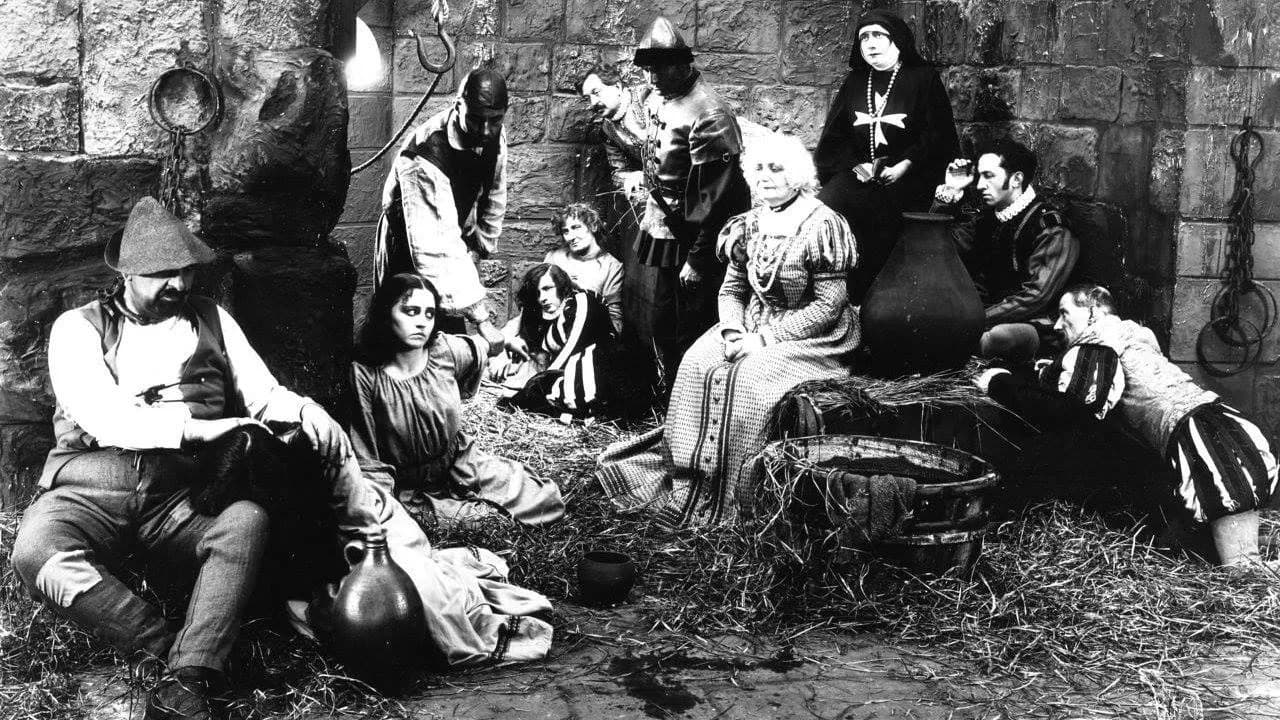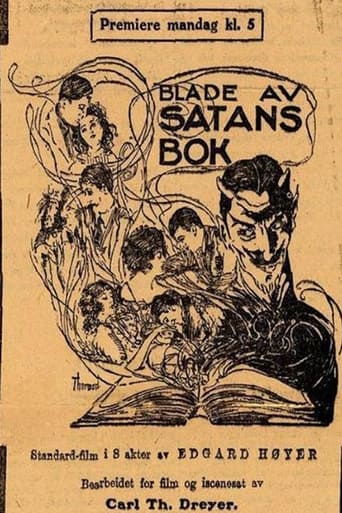

What a beautiful movie!
... View MoreExcellent characters with emotional depth. My wife, daughter and granddaughter all enjoyed it...and me, too! Very good movie! You won't be disappointed.
... View MoreThis movie feels like it was made purely to piss off people who want good shows
... View MoreMostly, the movie is committed to the value of a good time.
... View MoreThis movie...makes God out to be an obstinate Meany and Satan out to be a sympathetic character. That's not quite how it really is. I gave this movie a "1" because of that teaching. Anyone who believes that God is an obstinate Meany and Satan is a sympathetic character is in real trouble. There are some interesting elements to this film, but the teaching overshadows them. Yes, it deals with the Finnish Revolution, which I was not aware of until I saw this film. One earlier segment that I found interesting was around the time of Marie Antionette's execution. It refers to a her last letter, as if everyone should be familiar with it. I guess audiences of that time period might have been, but that's the first time I heard of it, too. Then there's Dryer. He's been made out to be a genius, but he comes across to me as an odd little man with funny ideas. Apparently, he thought God was an obstinate Meany and Satan was a sympathetic character. (I'll be he doesn't anymore!) If you must see a Dryer silent film, see The Parson's Widow (1920). Of the Dryer silent movies I've seen, it's the best of the lot.
... View More"Blade Af Satans Bog" ( Leaves Out Of The Book Of Satan ) (1921) was Herr Dreyer's most ambitious early silent film, a big "Nordisk" film production that depicts a challenge between Satan and God spanning 2000 years; fortunately the Danish Film Institute has shortened such a huge lapse of time to 157 minutes in a recent and beautiful film restoration for the pleasure of silent film fans around the world.This age old conflict is represented by four episodes: the betrayal of Herr Jesus by Herr Judas, the Spanish Inquisition, the French Revolution and the Finnish civil war in 1918. In "Blade AF Satans Bog" there are echoes of Griffith and certainly "Intolerance" (1916) was a big influence on Dreyer in terms of his film's construction and narrative not to mention the moral treatise. However Dreyer, unlike Griffith, is more interested in ethics than spectacle. Blade Af Satans Bog" is basically a moral story in the shape of a big film production, in which evil deeds and human weaknesses became a metaphor and eternal parable. The moral treatise mentioned by this Herr Graf is probably the most interesting aspect of the picture as the Danish director carefully develops the struggle between evil and good: Satan disguised as a Pharisee, a Grand Inquisitor, a Jacobin leader and a Bolshevik monk, must tempt his victims by appealing to their inner human weaknesses. In the background to this fight is religion, betrayal, ambition and power. The fallen angel knows how to persuade men towards his evil ends but is aware that there is no real comfort finally in his cruel doings. It is this aspect of the story that really counts for Herr Dreyer and he takes splendid advantage of the many technical resources at his disposal for this big budget film.Herr George Schnéevoigt was the cinematographer of the film and does excellent work, especially during the scene wherein Herr Jesus is praying in the Garden of Gethsemane. He also captures the dark atmosphere of the Inquisition and provides a human portrait of Frau Marie Antoinette. The cinematographer's use of light and shadows captures the tragic mood perfectly. This Herr Graf does not overlook the splendid and restrained acting by Herr Helge Nissen who, as the wicked Herr Satan, achieves a brilliant portrayal in his four different guises.And now, if you'll allow me, I must temporarily take my leave because this German Count must continue to speak evil of one of his Teutonic rich heiress to another one.Herr Graf Ferdinand Von Galitzien http://ferdinandvongalitzien.blogspot.com
... View MoreCarl Theodor Dreyer's second feature film is an ambitious study of evil through the ages, but the great Danish filmmaker is years away from his masterpieces of The Passion of Joan of Arc, Vampyr, Day of Wrath, Ordet and Gertrud. The inexperienced filmmaker was influenced by D.W. Griffith's 1916 Intolerance and aimed to map out the path of the Devil using Griffith's innovative filming style as a guide. He added on his realistic approach to the subject matter, as he believed realism to be the most essential part of any film.Like its inspiration, Intolerance, Leaves from Satan's Book contains stories from four historical periods linked thematically. Unlike Griffith's film though, Dreyer chose not to cross cut between stories, which makes for a less confusing film.Satan is the character who links the four stories. The film starts with his fall from grace, as told through inter-titles, and God's proclamation that he walk the Earth tempting humanity. For each soul that turns from God, 100 years will be added to Satan's sentence, but for every person who resists his temptations, 1000 years will be removed. Hoping to fail in his duties so that he may be admitted back into heaven, Satan tries to get men to betray what they hold most dear in four eras of history.The first section of the film is the biblical story of Jesus' betrayal by Judas. The next story takes place during the Spanish Inquisition. The third section of the film takes place during the French Revolution. The final segment is set in the Finland during the Russo-Finnish war of 1918. As a film, this wasn't Dreyer's best, but it was fairly entertaining. This early Dreyer film shows his almost innate ability to compose attractive images within the limits of the frame.Though this film isn't the grand spectacle he was hoping for, Dreyer did a wonderful job with it. His use of the film frame and style of story telling make this a movie interesting and attractive to watch.
... View MoreBLADE AF SATANS BOG (titled LEAVES FROM Satan'S BOOK on the DVD cover but LEAVES OUT OF THE BOOK OF Satan on the print) is a lurching silent film epic, running over two hours in length, that hypothesizes Satan's influence on weak-willed men and altering certain historic events. The film is divided into four highly variable sections, all taking place at different time periods, with the impressive Helge Nissen appearing as various guises as Satan in each segment. All are tinted a variety of different colors, from black-and-white to monochrome to lighter hues (blue, green, pink, etc.) and the cinematography, lighting, art direction, costumes and editing are often striking, just not often enough to completely overcome the uneven writing and a very slow pace.The first story is one we're all pretty familiar with - Jesus' betrayal by Judas, with Judas here being influenced by a turbaned and bearded Satan. Familiarity with this biblical tale takes the edge off and best can be said about this segment is in regards to a few moments of clever lighting (the last supper shot as another reviewer mentioned). The second story, set during the Spanish Inquisition, is an improvement. This is also the most horrific of the segments, with scenes set inside a torture chamber and Nissen's heavily-rouged face and intense, sneaky glares instantly bringing to mind Lugosi's classic Dracula character. Here, Satan plays Grand Inquisitor, leading astray a very nubile young love-struck priest who uses self-flagellation to rid his body of sin. One interesting scene features the priest whipping his back while envisioning the object of his desire draped below a cross (a shot I've seen used many times since).The third, and by far best, segment takes place during the French Revolution and opens with a striking shot of a guillotine sitting alone atop a hillside right as the sun is setting. This is also the strongest tale from a narrative standpoint as it cuts back and forth between two separate story lines but brings everything together at the end. A young man named Joseph helps a noblewoman and her daughter flee the city when authorities show up to execute the entire family for aiding the escape of a queen sentenced to death. When Joseph's advances are rejected by the daughter, Satan shows up to convince him to turn his back on both the mother/daughter, and later Marie Antoinette herself. The fourth segment, set in "modern times" (1918!) is about the Russian occupation of Finland and only has moments of occasional interest, both visually and thematically.There are a few memorable performances in this movie. Nissen is truly fascinating as all four visions of Satan; alternately creepy, clever, vengeful and weary. Also worth mentioning are Tenna Frederiksen Kraft, who is a graceful and sympathetic Marie Antoinette, and Elith Pio as Joseph, a man seriously torn between doing the right thing when lives hang in the balance... or just the right thing to advance himself.All in all, it's very slow and very uneven, but worth checking out if you are either a Dreyer completist or into silent pictures. But truth be told, the director has seen much better days; MICHAEL (1924), THE PASSION OF JOAN OF ARC (1928), VAMPYR (1932), VREDEN'S DAG (1943), etc.
... View More